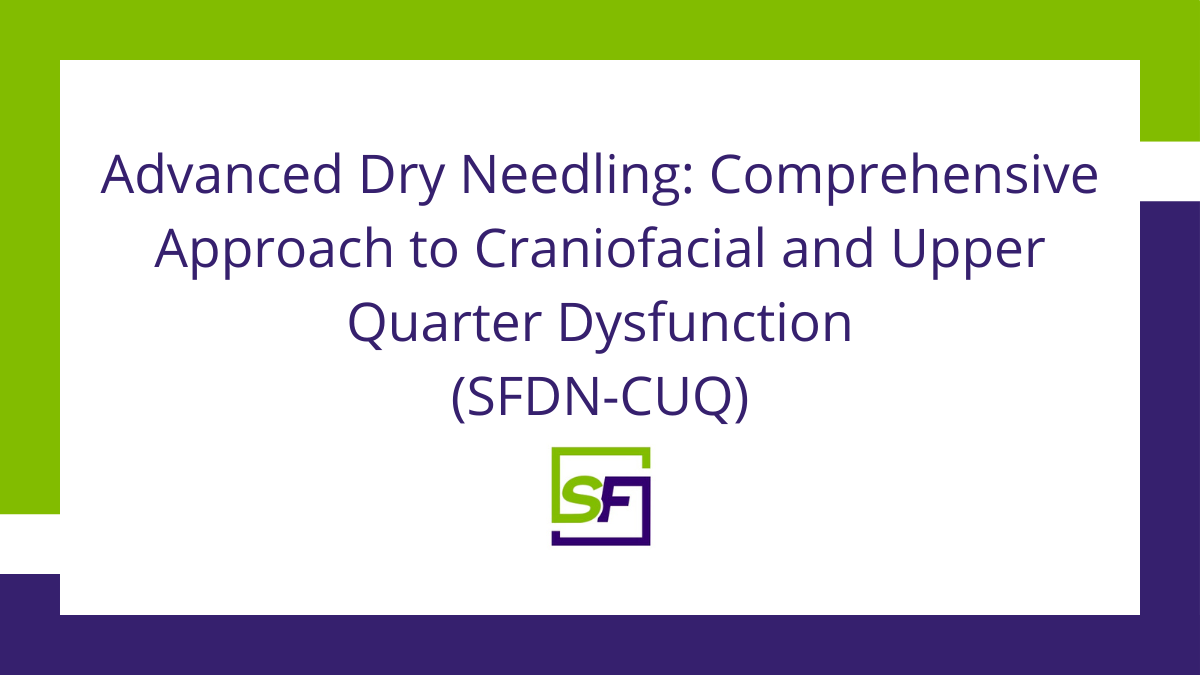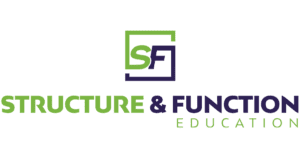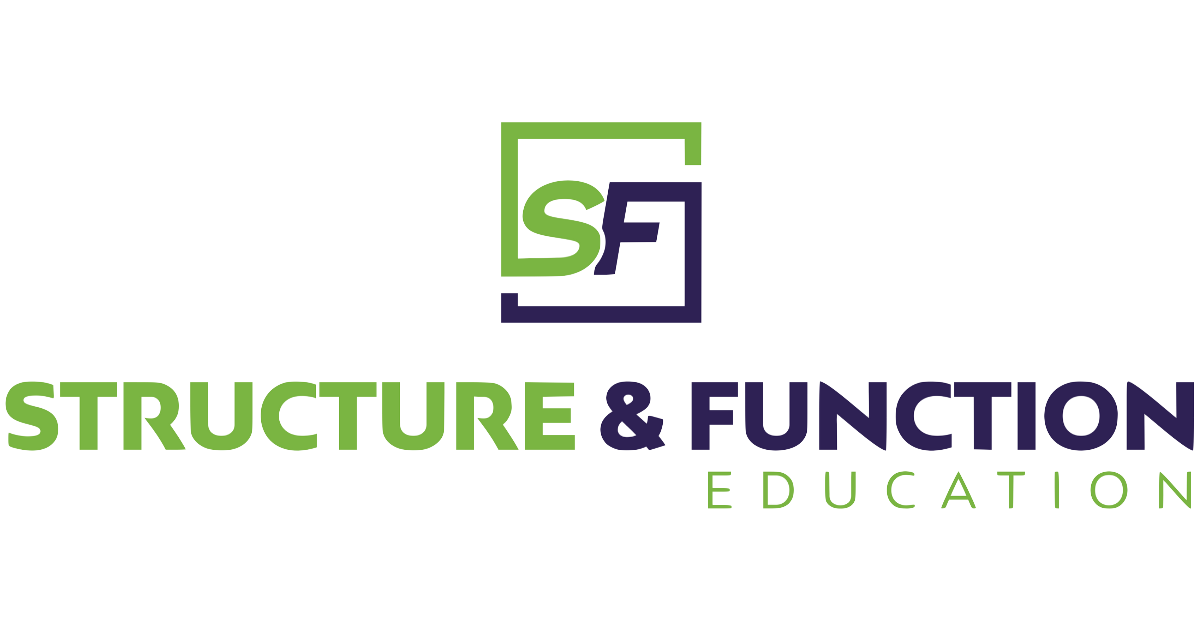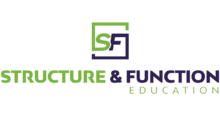Advanced Dry Needling: Comprehensive Approach to Craniofacial and Upper Quarter Dysfunction
In this 27-hour hybrid online and in-person lab-based course, the clinician will learn how to integrate dry needling techniques with a diagnosis-focused approach to address craniofacial and upper quarter dysfunction impairments. Diagnoses targeted include Migraines, Headaches, Occipital Neuralgia, TMJ, Thoracic Outlet, Brachial Plexus, and Rib dysfunction. This course includes new approaches to dry needling these diagnoses and additional rehab approaches, including manual therapy and cupping.
Click HERE to view our Course Map to understand how pre-qualification works for course registrations.
Prerequisites:
All students must have taken Foundations in Dry Needling for Orthopedic Rehabilitation and Sports Performance (SFDN1)
If you do not see your healthcare profession listed below, or practice outside of the United States, please contact us for more information. Professionals who may take this course include:
- Physical Therapists (PT)
- Athletic Trainers (AT)
- Chiropractors (DC)
- Doctors of Medicine (MD)
- Doctors of Osteopathic Medicine (DO)
- Physician Assistants (PA)
- Nurse Practitioners (NP)
Course Details:
Areas of the body to be covered in class include:
- Local Pathologies of the craniofacial regions, such as cervicogenic headaches, neuralgias, and TMJ disorders
- Ptygeriod, Masseter, Facial and Trigeminal Nerve
- Suboccipital muscles, along with Greater and Lesser Occipital Nerve
- Muscle energy and mobilization approaches to the TMJ, C0-C1 joint, Thoracic Spine, and Ribs
- Soft tissue approaches to levator scap, anterior scalene, middle scalene, post scalene, serrates posterior, SCM, 1st rib restrictions, CTJ long axis distraction.
- Thoracic Outlet Pathology with Median, Ulnar, and Radial Nerve Tracking
Upon completion of this course participants will confidently be able to:
- Describe mechanism of injury for the patient and how the injury can affect the cervical spine, craniofacial, and thoracic outlet
- Perform specific dry needling, muscle energy and rehab techniques for the cervical spine, craniofacial, and thoracic outlet
- Integrate surface anatomy palpation and layered anatomy application for safety considerations when inserting a dry needle into a patient.
- Utilize muscle origin, insertion, and action to confirm needle placement.
- Describe structural and soft tissue anatomy, appropriately insert a dry needle and consider depth and angle for application of safe and effective intervention to address patient complaints and therapist expected outcomes.
- Demonstrate a continuum of manual therapy mobilizations and muscle energy techniques to address cervical and thoracic spine joint restrictions.
- Demonstrate proficient instruction of corrective exercises to improve carry-over of manual interventions.
Required Reading:
- Dry needling in the management of chronic tension‐type headache associated with levator scapulae syndrome: A case report
- Gagnon P, Dunning J, Bliton P, Charlebois C, Henry N, Gorby P, Mourad F. Dry needling in the management of chronic tension-type headache associated with levator scapulae syndrome: A case report. Clin Case Rep. 2024 Apr 30;12(5):e8858. doi: 10.1002/ccr3.8858. PMID: 38689684; PMCID: PMC11060885.[Link]
- Dry Needling for the Treatment of Tension-Type, Cervicogenic, or Migraine Headaches: A Systematic Review and Meta-Analysis
- Pourahmadi M, Dommerholt J, Fernández-de-Las-Peñas C, Koes BW, Mohseni-Bandpei MA, Mansournia MA, Delavari S, Keshtkar A, Bahramian M. Dry Needling for the Treatment of Tension-Type, Cervicogenic, or Migraine Headaches: A Systematic Review and Meta-Analysis [Link]
- Pertinent dry needling considerations for minimizing adverse effects. Halle JS
- Halle JS, Halle RJ. Pertinent dry needling considerations for minimizing adverse effects – PART ONE. Int J Sports Phys Ther. 2016;11(4):651-662 [Link]
Suggested Reading:
- Anatomy for the acupuncturist–facts & fiction 1: the head and neck region. Peuker E
- Peuker E, Cummings M. Anatomy for the acupuncturist–facts & fiction 1: the head and neck region. Acupunct Med. 2003 Jun;21(1-2):2-8 [Link]
- Anatomy for the acupuncturist–facts & fiction 2: the chest, abdomen, and back. Peuker E
- Peuker E, Cummings M. Anatomy for the acupuncturist–facts & fiction 2: the chest, abdomen, and back. Acupunct Med. 2003;21(3):72–79 [Link]
Course Supplies
Required
- Portable Electrical Stimulation (e-stim) machine, we recommend one of these units (Use coupon code SAF15 for 15% off)
- If you have a latex allergy, it is recommended that you bring your own gloves for use during the lab.
Recommended
- Cupping set, either glass, plastic or silicon
Additional Information
For more information on CEU approval, please click here.
You will receive an email 30 days prior to the course you registered for with the following information:
- Any course-specific instructions such as location reminders, parking instructions, course check-in times, etc.
- Login information and instructions for your account on the online education platform.
- Your account information will allow you to take the online precourse and access to power points, class forums, course resources, course certificates, etc.
- You must complete the online precourse prior to your in-person lab dates.
Upcoming Courses
Important: The Foundations in Dry Needling for Orthopedic Rehabilitation and Sport Performance course is a prerequisite for this class.
Attendance Policy: Prior to registering for the course, make sure you are able to attend the entire weekend. Exceptions to this rule will not be allowed. For more details, please see the cancellation and attendance policy.

Learn Advanced Dry Needling: Craniofacial & Upper Quarter Dysfunction (SFDN-CUQ) in Boston, MA on Feb 21st, 2026
Marathon PT - Boston Vanderbilt Avenue, Norwood, MA, United StatesIn Boston, MA, on Feb 21-22, 2026, you can learn advanced dry needling with our Comprehensive Approach to Craniofacial and Upper Quarter Dysfunction (SFDN-CUQ) course. This is a 27 hour lab course where the clinician will learn how to integrate dry needling techniques with a diagnosis-focused approach to address craniofacial and upper quarter dysfunction impairments. Diagnoses targeted include Migraines, Headaches, Occipital Neuralgia, TMJ, Thoracic Outlet, Brachial Plexus, and Rib dysfunction. This course includes new approaches to dry needling these diagnoses and additional rehab approaches, including manual therapy and cupping.

Learn Advanced Dry Needling for Craniofacial & Upper Quarter Dysfunction (SFDN-CUQ) in Cincinnati, OH on April 18th, 2026
Mt. Lookout Chiropractic and Sports Injury Center - Cincinnati 455 Delta Ave, Suite 1, Cincinatti, OH, United StatesIn Cincinnati, OH, on April 18-19, 2026, you can learn advanced dry needling with our Comprehensive Approach to Craniofacial and Upper Quarter Dysfunction (SFDN-CUQ) course. This is a 27 hour lab course where the clinician will learn how to integrate dry needling techniques with a diagnosis-focused approach to address craniofacial and upper quarter dysfunction impairments. Diagnoses targeted include Migraines, Headaches, Occipital Neuralgia, TMJ, Thoracic Outlet, Brachial Plexus, and Rib Dysfunction. This course includes new approaches to dry needling these diagnoses and additional rehab approaches, including manual therapy and cupping.
Advanced Dry Needling: Comprehensive Approach to Craniofacial and Upper Quarter Dysfunction

In this 27-hour hybrid online and in-person lab-based course, the clinician will learn how to integrate dry needling techniques with a diagnosis-focused approach to address craniofacial and upper quarter dysfunction impairments. Diagnoses targeted include Migraines, Headaches, Occipital Neuralgia, TMJ, Thoracic Outlet, Brachial Plexus, and Rib dysfunction. This course includes new approaches to dry needling these diagnoses and additional rehab approaches, including manual therapy and cupping.
Course Provider: Organization
Course Provider Name: Structure & Function Education
Course Provider URL: https://structureandfunction.net/dry-needling-courses/sfdn-cux-advanced-dry-needling-craniofacial-and-upper-quarter/
Course Mode: Blended
Course Workload: PT27H
Duration: PT27H
Repeat Count: 2
Repeat Frequency: Daily
Course Type: Paid
Course Currency: USD
5

